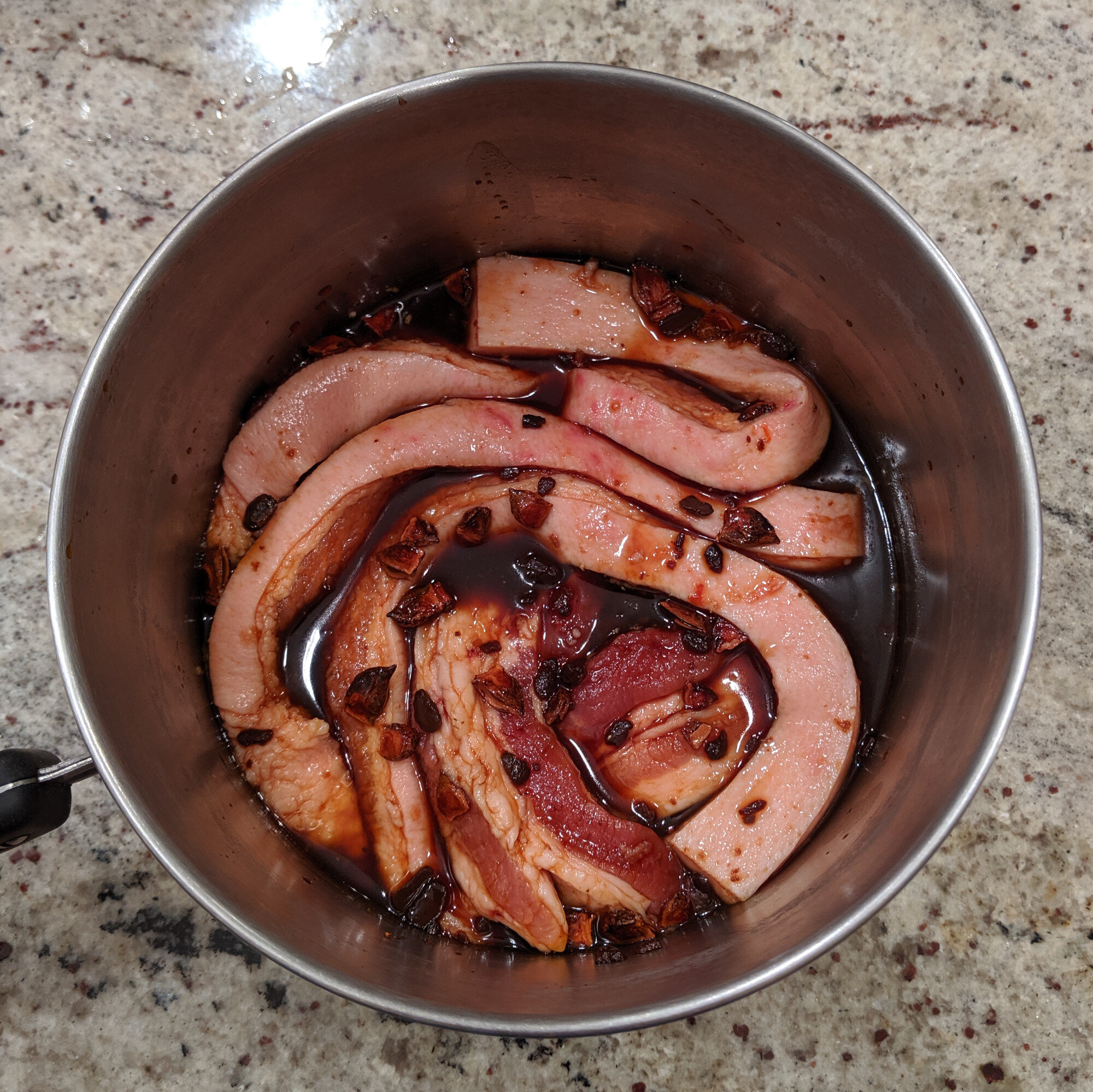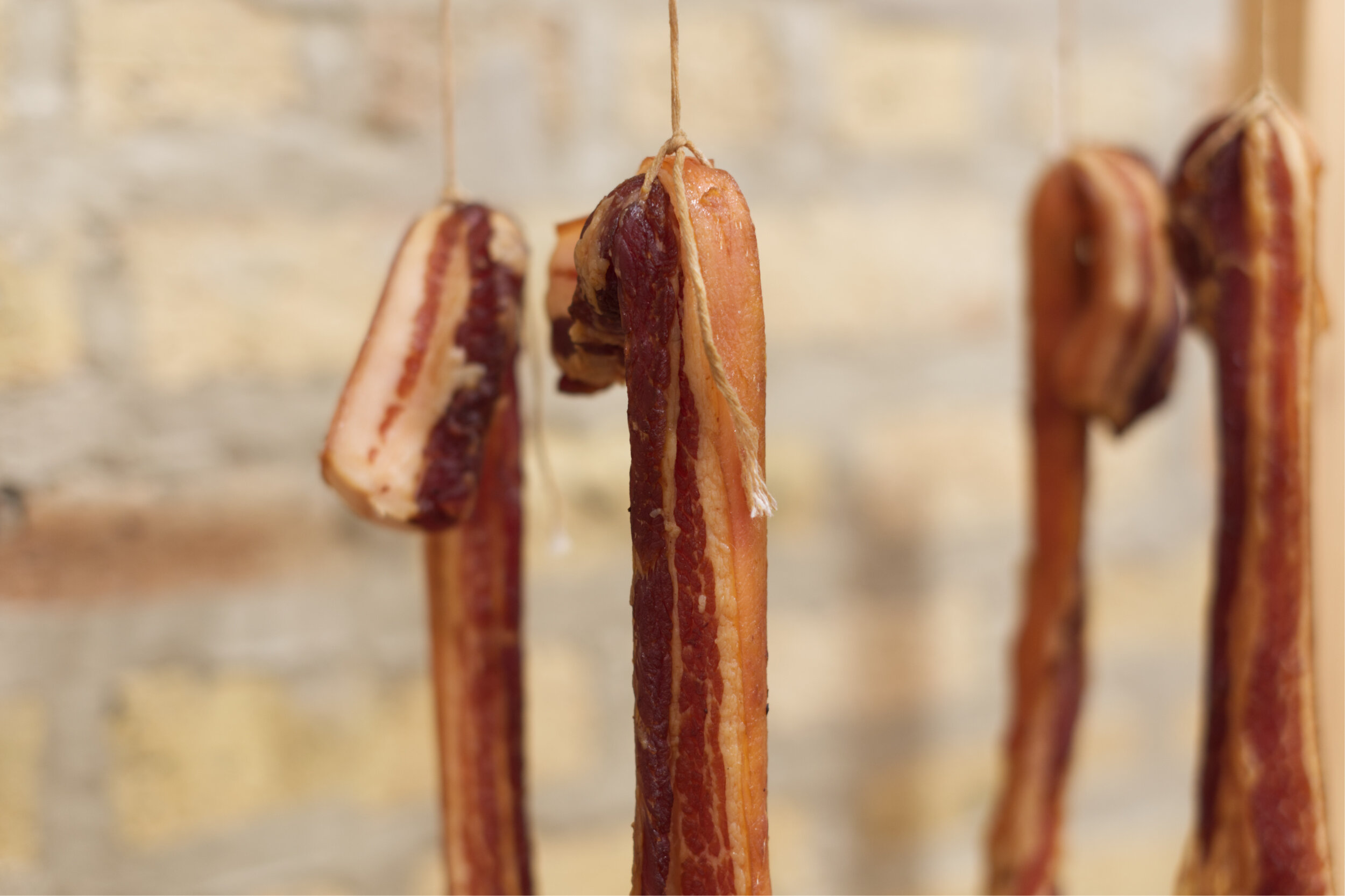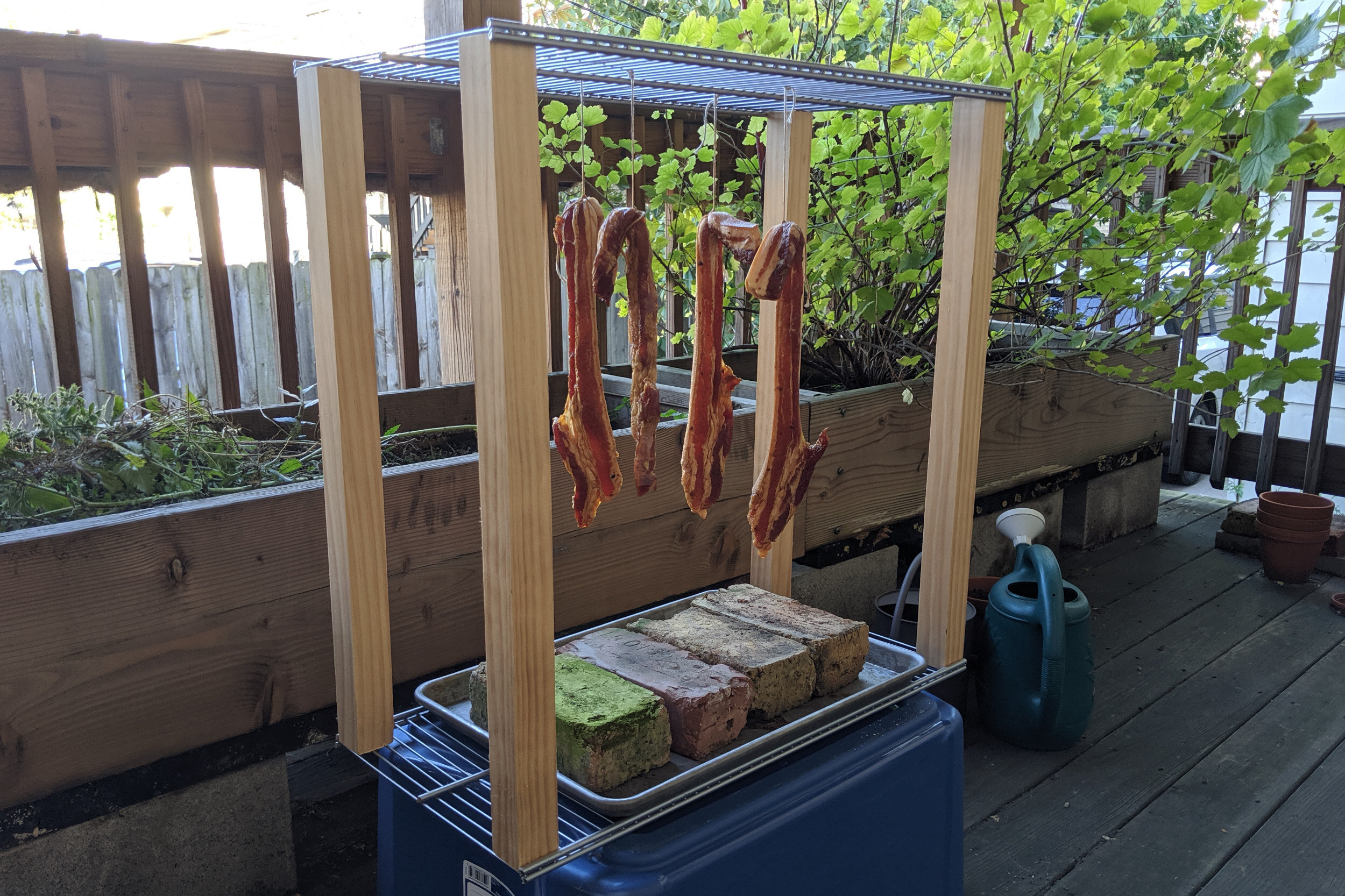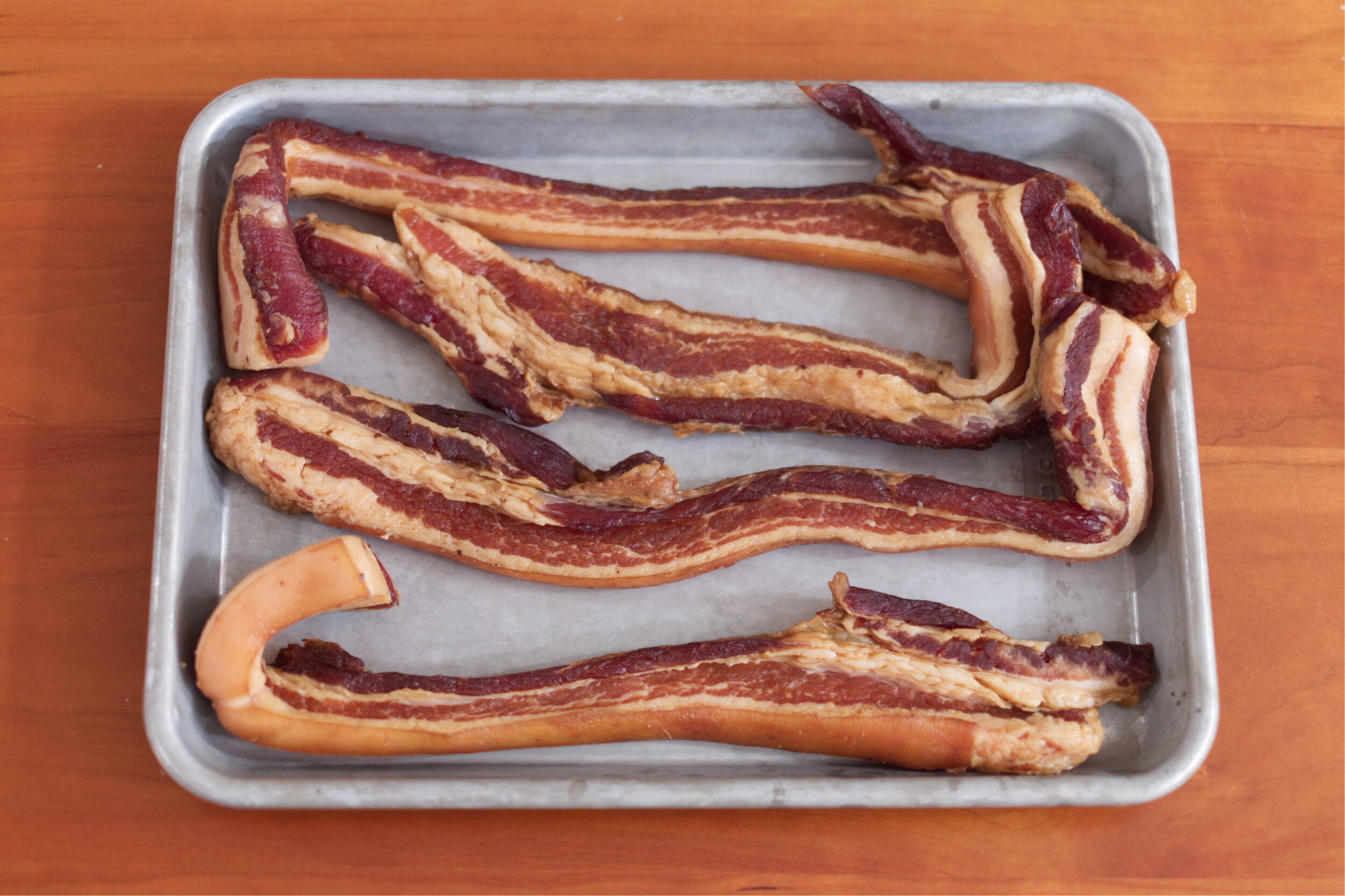Laap Yuk 腊肉

Fall is here with the arrival of brisk cold winds. About two weeks ago, I was in Chinatown going for dim sum with friends. On the way to the restaurant, I noticed a home where someone was making 腊肉 laap yuk. I wondered how this was made and asked my dad if he knows how to make it and it turns out it’s a pretty simple process. When he grew up (same goes for my mom), a refrigerator was non-existent and couldn’t be imagined. So foods had to be eaten fresh, preserved, or if it was cooked and had as left over, you had to reheat it the next day in intervals to prevent it from spoiling, but you still had to eat it very soon.
I thought this was a chance to record my dad giving me a recipe. I had some trouble trying to figure out how to record him until I bought a voice recorder to record him over speaker phone. But each time he gave me the recipe, it was a little different. The recording was made just after I tried making it for the first time and with older notes from my dad. The essential part of the recipe is to use pork belly and it’s cured in light soy sauce, salt, sugar, star anise, and liquor. I tried to make this like when he was growing up with no refrigeration as well, so when I cured the meat, it was just in a covered pot on the kitchen counter overnight.
If you understand the general Guangdong dialect, you’ll probably understand most of what he says. Specifically, our family speaks the Zhongshan dialect. But below is a rough translation of our conversation and typically how I get recipes from my dad.
Dad: Now, when you buy the pork, the BELLY, the belly and this has the skin on. So when get to cutting it, you rinse it first and then cut it slice by slice, about 3 bones wide. Slice by slice. Then rinse it and wipe it dry.
Then you use soy sauce… Soy sauce, there are two kinds. There is light soy sauce and dark soy sauce. Light soy sauce doesn’t have a lot of color to it and dark soy sauce has a very deep color. If you want to mix them, you can use both and to use the dark soy sauce for coloring. Next you will add salt, sugar.
Me: Right.
Dad: Salt and sugar. Next, for salt and sugar ratio, I guess it’s about -- just check the taste -- about 1 part sugar -- 1 part salt, 2 parts sugar -- just about and check what tastes good, right? Next, add star anise. For the star anise, crush it into pieces. Crush the spices. Soy sauce … liquor... Soy sauce, liquor. Salt, sugar, soy sauce, liquor are the core of this.
For the liquor at the minimum you should have 花雕酒 (Shaoxing yellow wine) fa diu jau. 花雕酒. Then, you asked if a lot needs to be added? Not much is needed. Such as, however much soy sauce you use, for the liquor you add … just about as much as you need. Once you prep it all in a bowl. You prep it all in a bowl, then you mix it and it’s ready.
Then you cure it. Cure it overnight. Cure it overnight until it soaks in the flavor. The next morning when you think of it, the next morning take some string, tie it up, and then sun dry them. If it’s very sunny, and northern winds are blowing, then one hour -- eight hours will dry it really nicely. If the 腊肉 has oil coming out of the surface, if the sides are simmering and oily, then it’s ready. Sometimes it’s not good to dry it took long, you know? Too dry doesn’t taste good.
So basically, to dry things, this is the Chinese way of doing it. Now, you said to add sauces, there’s none of it, right?
Me: Last time you explained this to me, you said you could use some 混合醬 -- A little, right?
Dad: You could and add a little bit to try it out. You should try it and see if it tastes good, but you only use a little. Not much. Just to soak in some of that flavor.
Me: Right. Right. And for the liquor … that’s the … uhhh … 玫 ... 玫瑰--
Dad: 玫瑰露酒 (Rose liquor) mui gwai lou jau. China’s 玫瑰露酒. If you don’t have 玫瑰露酒, using American liquor use what’s fragrant and high proof can work too. For Chinese liquor, it will be 玫瑰露酒. It’s very easy to buy this. It’s usually about $20 for a bottle, right? For about $19 a bottle, it will last a long time and you can cure a lot with it. When we buy it, it’s used for preserving, maybe stir frying, or making other things you can add a little liquor.
Me: Hmmm … Yeah … So …
Dad: -- So that’s about it.
Me: Yeah, and about the weather, how is it again when you sun dry it? If it’s too hot, then that’s bad?
Dad: No.
Ordinarily, any weather will work so long as there’s a strong sun shine and blowing northern winds. Blowing northern winds will dry the meat and skin. It will very quickly dry the surface. Once the surface dries, then oil will come out. If it doesn’t sweat enough, then you air dry it again the next day. That’s about it.
Me: Oohh, so when the weather is hot, you can still sun dry it?
Dad: If it’s hot out you can still dry it, but it’s not as easy. Hot weather--With hot weather, the humidity is high, also --
Me: Oooh --
Dad: Also, also, there are BUTTERFLY --
Me: Oh, yeah the flies--
Dad: The flies, will get at them, right? …
Northern winds--With northern winds, you won’t get them. So that’s the reason for that.
Me: Oooh, okay, okay.
Dad: Right? So it’s just that simple. It’s very fast to make it.
Me: Okay, okay, thanks.
RECIPE:
1 3/4 lbs pork belly (skin on)
1 1/2 c. light soy sauce
1/2 tbsp. salt
3/4 c. sugar
Pinch of MSG
4 star anise, crushed
1/4 c. 混合醬 wahn hahp jeung
1 tbsp 玫瑰露酒 (Rose liquor) mui gwai lou jau
sunshine (preferably full day and little clouds)
wind (preferably brisk northern winds)
*From a different phone call, just before I made this, this recipe reflects closer to what he said. The only key differences were that he said to add a pinch of MSG and a small amount of 混合醬 wahn hahp jeung just to barely thicken the marinade.
If the belly has excess blood from the store, rinse it and dry it off. Then cut it into long slices, about half an inch thick. For this recipe, I got 4 slices.
In a pot, combine the rest of the ingredients and adjust any to taste.
Add the pork belly and mix, and cover. Cure overnight.
The next day, transfer the pork belly slices onto a plate and with your hands, try to wipe off excess marinade so you don’t make much of a mess.
With kitchen twine, tie it up on any sort of rack so you can set it high above the ground. The lower this hangs to the ground, it’s more likely to pick up dust when the wind blows.
On a sunny day, preferably with cold winds, let this air dry for at least 8 hours. Once the surface is shimmering and some oil appears on the surface, it’s ready.









